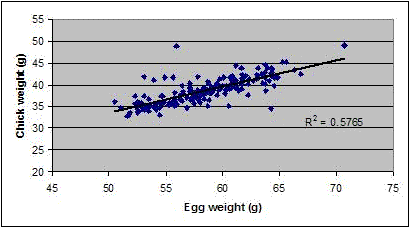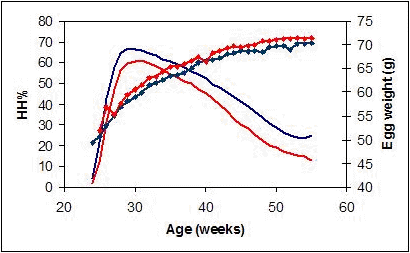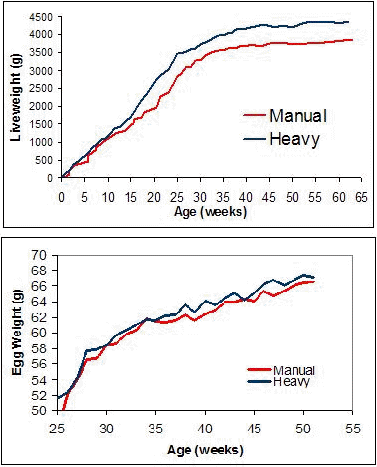



Controlling Late Egg Size
By Emma Fleming, Technical Development Manager, Aviagen - As a laying flock ages, egg weight increases due to bodyweight gain and reducing egg production after peak. Increased breeder egg weight over the course of the lifetime of a flock will have significant benefits to broiler performance.
Bigger eggs hatch bigger chicks (Figure 1) which are of a better quality with more residual yolk, and have a lower susceptibility to dehydration and heat loss. However, excessive increases in egg size, particularly during late production, have negative implications for egg quality and egg handling. Big eggs tend to have a poorer hatchability, poorer shell quality and an increased number of cracks. It is therefore important to manage egg size, particularly late egg size, appropriately so that a balance between broiler performance and egg quality can be achieved. Persistency of lay, bodyweight and nutrition all influence egg size and this article aims to summarise ways to manage these.

Figure 1: Relationship between egg and chick weight
Egg weight
There is a close negative relationship between egg production and egg size a drop in production leads to an increase in egg weight as the bird maintains egg mass. A flock with poorer production has a higher egg weight, particularly after peak. This difference of 1g at 55 weeks of age would also be expected if a sudden drop in lay after peak occurred, ( Figure 2).

Figure 2: Influence of production level on egg weight
These data show that maximising egg production throughout the life of the flock will assist in the control of late egg size. Rearing management should be directed towards achieving target bodyweights, to ensure the correct growth and development of the birds and a uniform and co-ordinated sexual maturity. The management of females into lay should be focused on stimulating and supporting egg production using the appropriate target bodyweight and recommended lighting programme.
Regular feed increases are essential to ensure the appropriate bodyweight gain and timely onset of lay. In early lay (pre-peak) achieving the correct bodyweight is also important and birds should be fed to meet the increasing demands of egg production and growth if production is to be maximised. It is vital to observe and react to the changing requirements of the birds at this time. Management of females post peak should be directed towards maintaining persistency of egg production by adjusting feed amounts in response to changing bodyweight and egg production,.
Bodyweight and egg weight
Higher bodyweights are generally associated with bigger eggs. Maintaining birds on a bodyweight profile that was significantly heavier than current recommendations, (+12% at 60 weeks) resulted in an increase in late egg size of approximately 1.5g (Figures 3a and 3b). This highlights the importance of adequately controlling bodyweight in lay. If there is also poorer persistency as a result of this increased bodyweight, the increase in late egg size will be exacerbated.

Figures 3a and 3b: Influence of bodyweight on egg weight
Sexual maturity and egg weight
The correlation between early and late egg size is very strong, so factors which affect early egg size will also impact on late egg size. The positive relationship between bodyweight and egg size is clear, a higher bodyweight at sexual maturity will affect egg size throughout the whole life of the flock. This may be beneficial for early egg size but is less desirable for late egg size.
Delaying the first light stimulation could affect egg weight as it will result in a heavier bodyweight at the onset of lay. However in Europe, delaying the age of lighting up from 19 to 22 weeks of age had no effect on egg number and helped counteract any increase in egg weight as a result of an increased bodyweight at onset of lay.
Nutrition and egg weight
Nutritional specification can partially control late egg size. However, this should be handled with care as it is essential that the bird receives the correct nutrition if maximum egg production is to be achieved.
The most important nutrients for control of egg size are linoleic acid, protein and some specific amino acids. Reducing the level of one, or a combination of these nutrients in the diet will reduce egg size. However, none of these nutrients should be limited before 40 weeks of age as this will reduce egg production. The introduction of an extra second stage breeder diet from approximately 45 weeks of lay may be beneficial in helping to control late egg size. For example, reducing the linoleic acid content of this diet would be beneficial, but this is more difficult to achieve in maize based diets than in wheat based diets. Lower protein the diet may also be beneficial but reduction in dietary protein can also reduce egg numbers as well as egg size.
The most significant amino acid in terms of egg weight is methionine. Reducing the methionine content of the second breeder diet would provide an option for controlling late egg size. Once again there is a very fine balance between supporting persistent egg production and controlling late egg size.
Recent data from The Netherlands showed that reducing the protein and linoleic acid content of the diet fed from 47 weeks of age reduced mean egg weight (48 - 60 weeks) by 0.7g without affecting rate of lay.
Whilst it is possible to control late egg size by manipulating nutrition such an approach should be exercised with caution so that egg production is not adversely affected.
Overfeeding and Underperforming
Flocks which are considered to be underperforming coming up to peak are often offered very high feed amounts in an attempt to remedy the situation. However, this course of action is rarely successful, often resulting in a more rapid fall in persistency after peak, poorer late hatchability and very high late egg weights. Figure 4 shows the difference in feeding pattern between the two flocks referred to in Figure 2. The poorer producing flock received more feed at peak and as a result a relatively severe feed withdrawal after peak.
This had a negative impact on persistency of production (Figure 2), and resulted in an associated increase in egg weight. These data highlight the importance of achieving good feeding management in lay, aimed at meeting the increasing demands of egg production and growth. However, birds which are fed more than they require for egg production will develop an abnormal ovarian structure and gain excess weight which will depress egg production and thus increase egg weight. Feed consumption after peak should take account of changes in bodyweight and egg production ensuring that flocks continue to gain weight and that the withdrawal of feed is not too rapid.

Figure 4: Difference in feeding regime between two flocks with differing production
Conclusions
Controlling late egg size should focus on achieving a balance between bodyweight control, egg production and egg size. If female bodyweight or egg production strays from target then there will be a consequent effect on egg weight if no response is made. The key to controlling late egg size is therefore persistency. Persistency of production, persistency of adequate bodyweight control and most importantly persistency of good management.
Source: Aviagen - June 2005












